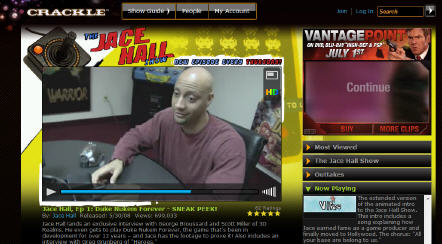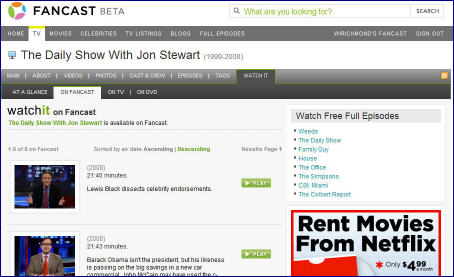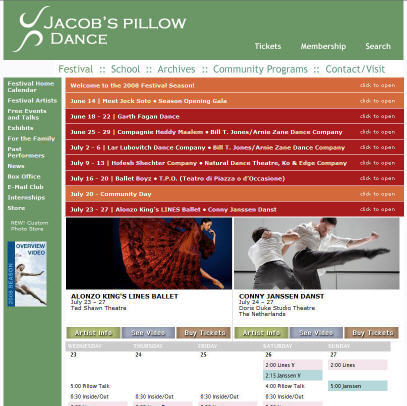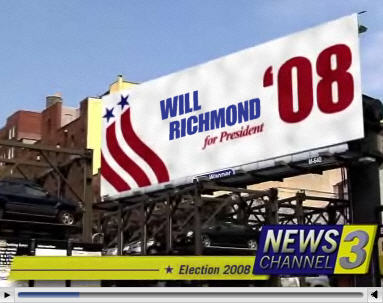-
MySpace-NBC's Decision '08 Contest: Elevating User Generated Video
Yesterday came a further positive sign that user-generated video may be elevated from the domain of karaoke-singing cats, faux-skateboarding accidents and exploding soda bottles.
That positive sign was MySpace, NBC and MSNBC's announcement of a new citizen journalism initiative dubbed the "Decision '08 Convention Contest." In it, MySpace users are encouraged to submit short videos answering one of three questions, "Why do you vote?" "Why are you the best person for this job?" or "How will you stand out in the crowd and get the scoop no one else can?"
The submissions will first be judged by a panel of experts from MySpace and NBC, with five finalists revealed for the MySpace community to vote on. Two winners will be selected, one to attend the Democratic convention this summer, and the other to attend the Republican convention.
To learn more about the contest and the motivations behind it, yesterday I spoke to Liba Rubenstein, MySpace's Manager of Public Affairs, who is essentially the product manager for the IMPACT channel, MySpace's hub for civic and social engagement. Liba explained that MySpace has used this type of contest frequently, and to much success. MySpace community members love getting involved and expressing their creativity. The two level judging process is meant to balance the experts' high editorial standards with members' passion and enthusiasm. Liba added that in particular MySpace and NBC are gaining insights about how to fuse traditional media with web 2.0. (And in a classic "doing well by doing good" vein, maybe NBC will discover the next Tim Russert in the contest.)
I like the Decision '08 contest for a variety of reasons. First and most importantly, it allows UGV to be directed to an important social use: increasing citizens' involvement in the democratic process. In this way it continues on what YouTube's YouChoose '08 pioneered by allowing its users to upload video questions in the recent primary debates. It may sound somewhat idealistic, but I really like the notion of broadband video doing its part to strengthen the functioning of America's democracy - even more so as we approach July 4th in this election year.
Further, I think the convention contest provides an example for how others outside the political realm might consider harnessing the creativity and passion of their members to use UGV in a directed purpose. One example that comes right to mind is in the education field. For example, wouldn't it be cool if educators uploaded UGV of themselves in action, explaining and demonstrating their proven teaching methods? I got a glimpse of some of this happening already, while doing a project last summer for the George Lucas Educational Foundation. There's no shortage of other examples.
There has been much hand-wringing about whether UGV can ever be monetized through advertising, a debate that will no doubt rage on. Alternatively, I for one would like to see more energy put into purpose-driven UGV projects like the MySpace-NBC convention contest. While I enjoy the cats, skateboarders and soda bottles as much as the next guy, I continue to believe the UGV medium can ultimately be so much more.
What do you think? Post a comment now!
Categories: Broadcasters, Partnerships, Politics, UGC
-
Crackle Notches an Early Win with "Jace Hall" Show
The broadband content provider Crackle is notching a win with its new comedy/interview series "The Jace Hall Show." I received a press release that it generated 500K visitors in the first two days following its launch on June 5th and a million to date. I'm always intrigued with what kinds of original broadband programs are working - and why - so I grabbed some time yesterday with Mary Ray, Crackle's VP of Marketing to learn what's behind Jace's success.
For those of you like me who are not gamers, Jason "Jace" Hall is probably unfamiliar. But Mary explained that if you're in the gaming community he's a fairly well-know producer who has a wide network of relationships in the industry. His show brings you into the world of his relationships, making you feel more connected to gamers' movers and shakers. And since he has his finger on the pulse of what the young male gamer audience is looking for, that gives him a real edge. Plus Mary believes that Hollywood still hasn't paid much attention to this market, despite gaming's huge following.
In the program's first episode Jace provided a sneak peek at a Duke Nukem Forever game that has reputedly been in development for 12 years. Gaining this type of access is practically like having exclusive content. Mary said that Crackle didn't do any advance paid marketing for the show; rather the audience was driven purely by word-of-mouth and buzz-building. I joked with Mary - spend no money but gain a big audience - the show sounds like a marketer's dream!
I asked Mary what she thinks the most important takeaway from Jace's early success is. Her feeling was that tapping into what the audience is hungry for is the key. While I agree, I'd go a step further. I think that trying to find talent that already has a following - whether in gaming, TV or some other medium - is a genuine way to improve a program's odds of success. I'm not necessarily talking about A-list talent per se, but rather talent that is at least known within some kind of niche (e.g. finance, comedy, woodworking, etc). That's not say "don't go with unknown talent looking to break out," but I do think it's important to recognize that doing so carries more risk.
The whole area of original broadband content is surging with players like Crackle, Next New Networks, 60Frames, ManiaTV, Break, Heavy, MyDamnChannel, FunnyorDie and lots of others pioneering the model. It's going to be very interesting to learn more about what works and why.
What do you think works in original broadband video? Share your comments now!
Categories: Games, Indie Video
Topics: 60Frames, Break, Crackle, FunnyorDie, Heavy, Jace Hall, ManiaTV, MyDamnChannel, Next New Networks
-
Comcast/Fancast, Hulu and the Role of Great Execution, Part 2
A couple of weeks ago in "Hulu Out-Executing Comcast in On-Demand Programming?" I took Comcast's Fancast to task because Hulu was first to implement its deal with Comedy Central for full episodes of "The Daily Show" and "Colbert Report." It was a missed opportunity for Fancast, which had previously announced a deal with Comedy Central for these shows. Hulu gained a bonanza of favorable press attention, likely spiking its usage.
Well fair is fair and so I'm now happy to report that Fancast has also posted these programs. But at the risk of sounding like a Fancast scourge (which I'm really not trying to be) Hulu continues to distinguish itself with a superior user experience. For those looking to succeed in broadband video the execution differences between these two sites provide key lessons.
First, after searching for The Daily Show on Hulu, the site automatically displays the most recent episodes first (beginning with last night's episode). When starting the player, Hulu's quick 7 second "brand slate" runs and then the program starts. This emphasis on a quick payoff no doubt reflects lessons Hulu's CEO Jason Kilar learned from his years at Amazon, which, like all great e-commerce sites knows that a distraction-free checkout process results in more completed transactions.
Conversely, at Fancast, after doing a search for Daily Show, the results are "Sorted by air date Ascending | Descending." Ascending is pre-selected, and the first episode shown is from April 9th, with Lewis Black. Huh - why such an old episode being shown first by default? And is the average user really going to be familiar with these sorting terms? Why not just offer choices like "Newest" and "Oldest" with "Newest" as the default?
When I tried watching several episodes I encountered more distractions and inconsistency. I alternatively saw a 30 second pre-roll, a 15 second pre-roll and once I even got back-to-back 15 second pre-rolls (of the same A1 steak sauce ad no less). Contrast this with Hulu where each time I knew to expect the voiceover intoning "The following program is brought to you...." Hulu understands that positive online experiences emphasize usability and consistency.
Separately, Hulu offers the ability to send a link to the full episode to a friend or clip just a segment, which can also be posted easily to a number of social networking sites. The features worked flawlessly and when done the video resumed playing automatically. On the other hand, an envelope icon at Fancast reveals 2 sharing options, "Beginning of Video" or "Current Scene." Yet after clicking on both they seem to reveal the same screen. So what's the difference? Worse, after finishing up sharing, the video was frozen, forcing me to close the browser and start all over again. Ugh.
Just to be clear, I don't expect perfection and I do recognize that Fancast is still in beta. To put all this in some context and explain why I'm dragging you into the weeds with this part 2 post, I've long believed that broadband's openness will allow new aggregators to emerge, attempting to compete with incumbents like cable and satellite operators. Differentiating themselves is no small feat considering, as in this case, the underlying content they have will likely be similar to what's available elsewhere.
Hulu is differentiating itself through great execution - particularly noteworthy for such a young site. My
 guess is that execution and usability DNA run very deep within the Hulu team. On the other hand, Fancast has not yet demonstrated comparable execution mastery and as a result is leaving the competitive door ajar for its customers to give Hulu a try. Winning Hulu users back to Fancast will be tougher than winning them now.
guess is that execution and usability DNA run very deep within the Hulu team. On the other hand, Fancast has not yet demonstrated comparable execution mastery and as a result is leaving the competitive door ajar for its customers to give Hulu a try. Winning Hulu users back to Fancast will be tougher than winning them now. Broadband aggregation is going to be a battleground with big eventual payoffs. As a powerful incumbent, Comcast must do everything possible to preclude users from seeking out Hulu and other aggregators. (Truth be told, it is unlikely these broadband aggregators would have raised close to the $366+ million I recently reported in the first place had Comcast and other incumbents proactively seized the online aggregation space several years ago. But that's a story for another day.)
For all the time I spend talking about strategy at VideoNuze, I've always been a big believer that competition is mostly won in the trenches. That's especially true in online where great execution and usability separate winners from the rest. For Comcast, the competitive bar is far higher than it has ever been. To succeed, it must significantly improve its execution.
Categories: Aggregators, Cable Networks, Cable TV Operators
-
New Strategy Analytics Research Underscores Video Consumption Shifts Among Young
I recently attended a presentation by Martin Olausson, Director of Digital Media Strategies at Strategy Analytics, who shared key findings from his firm's recently fielded digital media survey. Strategy Analytics
 is a research and consulting firm specializing in information, communications and entertainment. In a follow-up chat, Martin provided a little more color on the data and he also agreed to share a half dozen slides as a complimentary download for VideoNuze readers.
is a research and consulting firm specializing in information, communications and entertainment. In a follow-up chat, Martin provided a little more color on the data and he also agreed to share a half dozen slides as a complimentary download for VideoNuze readers.Click here to download the slides.
Some of the most interesting data confirms the shifts that are well underway in how younger people consume video. For example, the weekly TV reach for 15-19 year olds is 64%, while for 35-49 year olds it's 82%. Conversely, the weekly reach for broadband video averages around 25-26% for those in the 15-29 age brackets, but at 35-49 it drops to 15%, and then for 50+ it drops again to just 5%. Broadband consumption clearly skews younger, suggesting a more permanent shift as this group ages.
In addition, 16-18% of 15-29 year olds said they'd be interested/very interested in paying for TV online, while only 11% of those 35-49 said so, and only 3% of those 50+ said so. Similarly, 21-22% of 15-29 year olds said they'd be interested/very interested in paying for movies online, while only 16% of those 35-49 said so, and only 5% of those 50+ said so.
Media and marketing executives need to focus on what opportunities this creates. For example, this might suggest that special offers to download TV programs and movies that have particular appeal to younger people might help accelerate the paid business model. Or that co-marketing deals with other brands that already have credibility and reach into these age groups would help open up the market.
Strategy Analytics also included a revenue forecast for various business models for 2008-2012. The four paid categories, "Download to Own: Movies," "Download to Own: TV," "Download to Rent: A-La-Carte" and "Download to Rent: Subscription" total up to approximately $3.87 billion by 2012, while the ad-supported category totals to $3.48 billion by then.
Martin is most bullish on the subscription model as the big driver of paid revenues, and focuses on Netflix in particular as having a strong online delivery opportunity. While I haven't created my own revenue projections, I still bias toward thinking ad-supported will outstrip paid in the next 3-4 years. If I look longer-term, say 5-10 years out, I can see that shifting to the paid model as today's issues (portability, rights, mass broadband connectivity to TVs, etc.) are resolved at scale.
Taken together, the data adds to our understanding of what's happening in the market today and where things may be heading. If you want further information about the survey, Martin's contact information is on the cover slide.
Categories:
Topics: Strategy Analytics
-
Disney/ABC - Veoh Syndication Deal Provides More Clues About Market's Future
More evidence this morning of the Syndicated Video Economy playing out, as Disney is announcing it will distribute both ABC and ESPN programming to Veoh, the broadband video aggregator. This follows ESPN's first and recent syndication deal with AOL.
Last week in "Disney/ABC's Cheng is Confident About Broadband Video Advertising," I explained how Disney places a huge emphasis on its video player, so that it can present a consistent user experience and also control advertising. The Veoh deal is aligned with that thinking. Veoh users are exposed to Disney programming, but once they want to view, the Disney video player launches.
In fact it's interesting, if you compare what's been implemented so far at Veoh vs. how ABC shows come up
 at Hulu (an aggregator that Disney does not have a deal with), there's not that much difference. Recall that Hulu is just taking a feed of Disney's program-related metadata, but again, if you actually want to view, you'll launch the Disney video player.
at Hulu (an aggregator that Disney does not have a deal with), there's not that much difference. Recall that Hulu is just taking a feed of Disney's program-related metadata, but again, if you actually want to view, you'll launch the Disney video player. I'm guessing the major difference here, and why some money changes hands with Veoh, but not Hulu, is that Veoh must be making some kind of commitment to promote Disney programs. Though you never want to judge a deal by how it's implemented on day 1, for now Disney doesn't seem to getting much visibility. I noticed a Jimmy Kimmel thumbnail rotate through the Veoh home page, but when I drilled down through the "TV Shows" and "Channel" tabs, I didn't see any extra promotion of ABC programs. In fact the only ABC program even listed in Veoh's generic alphabetized directory was "Ugly Betty." I found a few full-length episodes when I drilled down through an "ABC" link I found with the Kimmel video, but couldn't find that link anywhere else.
All of this is a reminder that there's a very interesting minuet going on between established networks looking to broaden their online reach and the big video aggregators that have grown dramatically and raised lots of money, but are still unprofitable. The Disney-Veoh deal shows that aggregators may be willing to agree to networks' desires for online control in exchange for the potential to generate high-margin promotion-based revenue (remember they're not hosting or delivering the Disney video, so for Veoh in this case there's very little expense involved) and incremental on-page ad revenue. Of course too many of these kinds of implementations and the aggregator's user experience will look quite inconsistent.
No doubt there will be many more network-aggregator deals yet to be done, demonstrating how this market will eventually shape up.
Categories: Aggregators, Broadcasters
Topics: ABC, Disney, ESPN, Veoh
-
PermissionTV Enhances Customization, Scalability
More news today in the video publishing space as PermissionTV is making two product-related announcements with an eye toward enabling easier, faster creation of video applications by media
 companies, brands and third party agencies. Specifically the company is releasing its Platform Development Kit (PDK) and "Solutions Hub." Last week Corey Halverson, PermissionTV's VP of Product Management gave me a demo and rundown of both.
companies, brands and third party agencies. Specifically the company is releasing its Platform Development Kit (PDK) and "Solutions Hub." Last week Corey Halverson, PermissionTV's VP of Product Management gave me a demo and rundown of both."Solutions Hub"
The "Solutions Hub" is a gallery of video player applications that Permission is offering developers use of to help jumpstart their video efforts. The examples are both pragmatic and inspirational, showing developers for the kinds of things that can be done with Permission's tools.
Corey explained the Solutions Hub is meant to address a phenomenon that Permission often encounters: developers who have expansive visions of the kinds of apps they'd like to build, but who still need grounding to help them get started quickly and easily. The Solutions Hub addresses this by providing a range of downloadable apps including many featuring integrations with 3rd parties (e.g. DART, Move Networks, Tremor). By anticipating developers' needs, Permission is aiming to accelerate time to market.
PDK
Targeted to agencies that need to be able to create highly customizable applications quickly but on a budget, Permission's new PDK bundles together all of its APIs, with tutorials, reference players, source code and other Flash-oriented tools. Corey characterized the PDK as allowing developers to "color outside the lines," while providing as much functionality as possible right out of the box.
While I'm not a Flash developer and therefore can't fully appreciate some of the details of the PDK, there's no question that as the market matures a blend of customization and scalability is required to succeed. In particular, as business models remain in flux and experimentation prevails, the ability to quickly and inexpensively try different approaches is key. Taken together the Solutions Hub and PDK look like solid forward progress to meeting these market objectives.
Categories: Technology
Topics: PermissionTV
-
Jacob's Pillow Uses Video to Enhance Customer Experience
As you can likely imagine I'm always on the lookout for interesting uses of broadband video. Periodically I get a heads up from others about something they've spotted; now, even closer to home, my wife has brought me an example.
In the summer we spend a lot of time in the Berkshire Mountains in western Massachusetts. Occasionally we go to a summer dance theater there named Jacob's Pillow, which my wife enjoys attending. The performers range from classic ballet to some pretty cutting edge modern stuff. I'll concede I'm not a big fan myself, but since it's hard to play golf at night, I'll oblige by joining her once or twice each summer.
The problem that always arises is choosing which performances to attend. Pictures and a text description are really not adequate to capture what you might see in a dance performance. Unless you really know these performers there's a lot of guesswork. As a result, over the years we've seen some good stuff and some weird stuff.
This summer though, Jacob's Pillow did something very smart, which my wife noticed and told me about. On its web site, for each performance, there is now a "See Video" button, which allows you to see an actual clip of the performers in action. Though they're mostly lower-quality clips hosted at YouTube, they give you a real flavor of what to expect. I'd be willing to bet that these videos are getting noticed and are helping increase attendee satisfaction.
While I spend a lot of time at VideoNuze on the tectonic influences of broadband video such as how it affects broadcasters' economics or shifts advertising spending, Jacob's Pillow is another great example of how broadband's myriad uses can help different businesses deliver more value to their customers. If you have any examples, please send them along!
-
Richmond for President? No!
Sharing a little Friday fun that Joel Smernoff at Paltalk sent over to me. Click on the image below to see the full video. Kudos to him and his gang for this cool app - try it yourself. And in case you're wondering, I'm not considering any job changes...Categories: Miscellaneous







